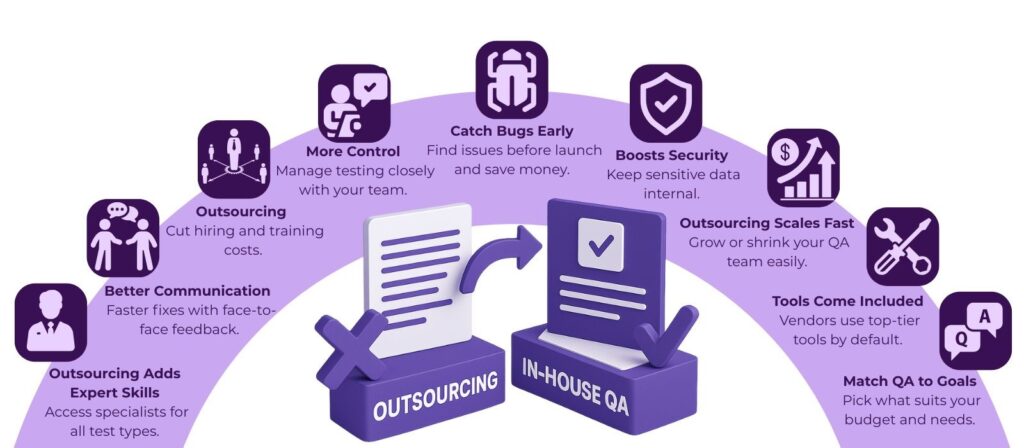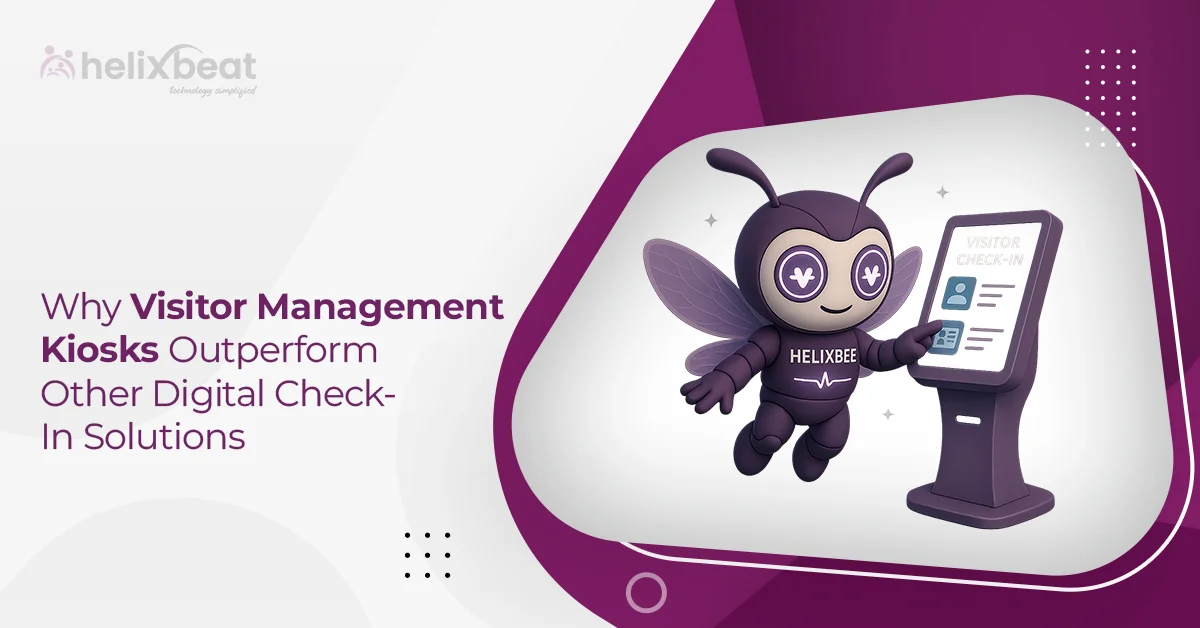Did you know? Software problems cost businesses about $1.7 trillion every year, and almost half of IT budgets go to fixing issues after release. This shows why good QA testing services are so important to deliver reliable and safe software.
QA testing helps identify bugs early, assess software performance, and ensure the security of user data. Having an in-house QA team gives you more control but can be expensive. Outsourcing QA can save money and bring expert help but may cause worries about communication and security.
Choosing between in-house and outsourced QA depends on your business needs and resources, whereas Helixbeat’s QA testing services offer flexible options to fit your goals. Whether you want to add to your team or outsource fully, Helixbeat uses advanced testing to help you deliver better software faster and safer.

Table of Contents
What Is QA Testing Services?
QA testing services are a set of processes that verify software to ensure it functions correctly, is free of bugs, performs efficiently, and remains secure before it reaches users. These services include various types of testing like functional, performance, security, and usability testing. By identifying and resolving issues early, QA testing enables businesses to deliver reliable, user-friendly software, minimise costly errors, and safeguard their brand reputation.
Understand the Difference Between In-house and Outsourced QA testing Services
| Aspect | In-House QA Testing Services | Outsourced QA Testing Services |
| Control | Full control over testing processes and priorities | Limited control; depends on vendor’s processes |
| Communication | Direct, real-time communication with development teams | Communication may face delays and barriers |
| Expertise | Team may have deep product knowledge but limited specialized skills | Access to a broad pool of experts, including niche areas like performance testing |
| Cost | Higher fixed costs due to salaries, training, and infrastructure | Often more cost-effective with flexible pricing models |
| Scalability | Limited by team size; scaling requires hiring and training | Easily scalable to match project needs and deadlines |
| Speed | Faster issue resolution due to proximity | Potential delays due to coordination and time zones |
| Security | Higher data security as everything stays within the company | Possible risks; depends on vendor’s security protocols |
| Tools and Technology | May require investment in latest tools and licenses | Vendors typically provide access to advanced tools |
| Flexibility | Less flexible to sudden changes or workload spikes | More flexible to adapt to changing project requirements |
| Long-Term Investment | Builds internal expertise and loyalty | No internal team development; knowledge resides with vendor |
Why Businesses prefer In-house QA Testing
Keeping QA testing services in-house offers several advantages that can directly impact the quality and speed of your software development process. Here are some key benefits of maintaining an internal QA team:
- Better Communication and Collaboration: Close proximity allows for faster feedback and clearer communication between developers and testers.
- Deeper Product Understanding: In-house testers develop a strong knowledge of the product, leading to more effective and targeted testing.
- Greater Control Over Processes: Direct oversight ensures testing aligns perfectly with company standards and timelines.
- Faster Issue Resolution: Immediate access to the development team allows quicker debugging and fixes.
- Customized Testing Strategies: Tailored QA approaches can be developed to suit unique business needs and workflows.
- Stronger Data Security: Sensitive information stays within the company, reducing risks related to data breaches.
- Long-Term Team Investment: Building an internal QA team fosters expertise and loyalty, supporting ongoing product quality improvements.
While in-house QA testing services provide these clear benefits, it’s important to weigh them against factors like cost, scalability, and access to specialized skills when deciding the best approach for your business.
Reason for Choosing Outsourced QA Testing Services
Outsourcing QA testing services offers businesses several strategic advantages. The following points highlight why many companies prefer external QA teams to handle their testing needs.
- Access to Expert Skills: Outsourcing provides access to experienced QA professionals with specialized skills in areas like automation, security, and performance testing.
- Cost Savings: It reduces expenses related to hiring, training, infrastructure, and employee benefits, making QA more budget-friendly.
- Scalability: Outsourced teams can quickly scale testing resources up or down to match project requirements and timelines.
- Faster Testing Cycles: Dedicated external teams often enable quicker turnaround times, helping accelerate product releases.
- Use of Advanced Tools: Vendors typically invest in the latest testing technologies and tools, which may be costly for in-house teams.
- Focus on Core Business: Outsourcing QA frees internal teams to concentrate on product development and other strategic activities.
Outsourcing QA testing services allows companies to leverage specialized expertise, reduce costs, and accelerate delivery timelines all while focusing internal resources on core business goals.
How to Select the Right QA Testing Services Provider
1. Evaluate Technical Expertise and Experience
When choosing a QA testing services partner, assess their technical skills and industry experience. Look for teams proficient in various testing types, including functional, automation, security, and performance testing services. By collaborating with well- experience experts help you to understand your specific challenges and requirements.
2. Check Communication and Collaboration Capabilities
Effective communication is crucial for successful QA partnerships. Ensure the provider offers transparent, timely updates and has a collaborative approach to working with your internal teams. Clear communication helps prevent misunderstandings and keeps the testing process aligned with your project goals.
3. Assess Flexibility and Scalability
Your QA needs may change as projects evolve. Choose a partner that can easily scale resources up or down and adapt to shifting priorities. Flexibility in engagement models, whether project-based or ongoing support, allows you to manage costs while maintaining high-quality QA testing services.
Choosing the right QA testing services is essential for delivering high-quality, reliable software on time and within budget.
Whether you opt for in-house or outsourced testing, prioritizing expertise, communication, and flexibility will help ensure your software meets user expectations and business goals.
Why Helixbeat Excels in Providing QA Testing Services
At Helixbeat, delivering exceptional QA testing services is more than just a process; it’s our commitment. Our experienced team combines deep technical knowledge with the latest testing tools to cover everything from basic functionality to complex performance testing services.
What sets us apart is how we work closely with our clients, maintaining clear communication and customizing our approach to fit each project’s unique needs.
This makes us help businesses to release reliable, secure software faster. Don’t let bugs slow you down. Choose Helixbeat’s QA testing service for smooth launches.
FAQ:
1. How much does a QA tester cost?
The cost of a QA tester depends on experience, location, and project complexity. It can vary widely, with some testers charging hourly rates or fixed project fees. Outsourced QA testing services typically offer flexible pricing based on the scope of work.
2. What testing does QA do?
QA testing includes various types, such as functional testing, performance testing, security testing, usability testing, regression testing, and automation testing. Each type ensures different aspects of the software are working correctly and meeting quality standards.
3. What is a QA testing tool?
A QA testing tool is software that helps testers automate, manage, and execute testing processes. These tools assist in test case management, bug tracking, performance monitoring, and automated test execution, improving accuracy and efficiency.
4. What are the qualifications for QA?
Qualifications for QA roles typically include a background in computer science or related fields, knowledge of software development life cycles, understanding of testing methodologies, and skills in manual and automated testing. Certifications like ISTQB or CSTE can enhance credibility.
5. What is performance testing as a service?
Performance testing as a service is a cloud-based solution where specialized providers conduct tests to evaluate how the software performs under various loads. It helps identify bottlenecks, ensure stability, and optimize speed without requiring in-house infrastructure.
6. Which is the best tool for performance testing?
The best tool for performance testing depends on project needs, but popular options include Apache JMeter, LoadRunner, and NeoLoad. These tools are widely used for their scalability, ease of use, and comprehensive reporting features.














